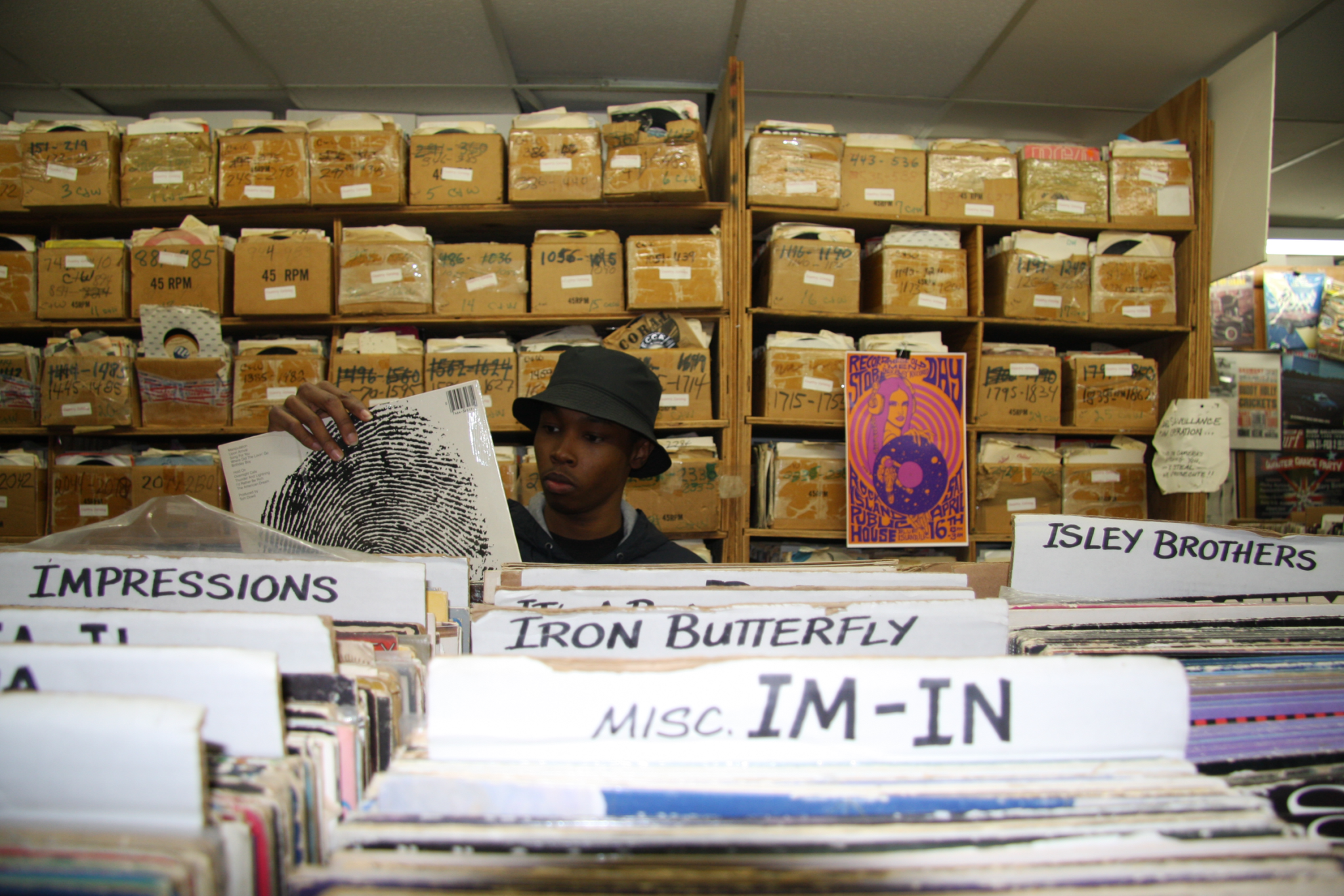I meet twenty-year-old hip-hop producer George Miller (stage name Hooligan) at Beverly Records, just a few miles north of his Calumet Park home. As more casual customers come and go, Miller scours stacks of LPs and boxes stuffed with 45s one by one. He’s searching for new sounds to take home and feed to his MPC—an analog music sampler and drum machine. Eyes barely showing from under his bucket hat, Miller navigates his slim frame through the cramped space, pulling Jack Bruce, Boz Skaggs, and Cal Tjader records from the shelves and into his armful of purchases.
“Soul music is something that I’ve always been in tune with,” Miller says. “My pops was always playing Marvin Gaye, The Isley Brothers, Prince”—the list goes on. In fact, he tells me how he was so inspired by Prince’s music as a child that he talked his dad into getting him an electric guitar just to emulate the artist. “He was one of my first musical influences,” Miller explains. “I couldn’t believe it when he passed.”
Not long after trying his hand at Prince-inspired guitar solos, Miller heard Dr. Dre and the Wu-Tang Clan for the first time. “That changed everything,” he explains. “My mom would try to keep me from listening to that stuff. She would even go through my iPod, but eventually she knew she couldn’t keep me from it.” But once Miller realized that both Dre and Wu-Tang sampled from records he’d been listening to all his life, he was really hooked. The eureka moment that pushed Miller from music fan to music maker came when he heard RZA’s production on Wu-Tang’s 36 Chambers album. The off-kilter piano loops and sloppy but melodic arrangement of each song’s heavy-hitting drums sparked an urge to create that Miller never knew he had.
“The way [RZA] layered sounds and stacked records was odd and eerie, but in a good way,” Miller explains. “The combinations of sounds were just always unexpected, and that really pushed me in the right direction.”
This newfound infatuation led Miller to ask his father for yet another purchase—a Casio keyboard. “It wasn’t supposed to be a sampler,” Miller says of the keyboard model. “It had sampling capabilities but that’s not what it’s meant for.” Trying to recreate beats from Snoop Dogg’s Doggystyle album with only ten seconds of sample time wasn’t easy, but Miller says the difficulty was essential in teaching him the importance of detail and invention in beat production.
When Miller’s aunt passed, she left him a few boxes of old soul records. “After that was when I really started digging,” he explains. “I started reading the names on the back of the records to see who was playing what—this guy plays strings, or this guy plays drums.” Now when Miller looks for new sounds, he can study the names of the session players in the liner notes and get a good feel for the record’s sound before he even listens to it.
Miller outlines his creative process by taking me through the track titled “Drift” from his beat tape, BlankCassette. “This was the most challenging track on the whole project,” he says. “I made the original beat and it just wasn’t clicking. I was about to scrap it when I heard another sample that might work with it.” The main sample comes from a song on a 1987 electronic record by English composer Paul Williams, a spacy ambient song with little structure to it. After chopping, arranging, and layering the sample with drums and a filtered bass line, “Drift” becomes tighter and more rhythmic, a beat to zone out to. “It’s all about filtering,” he says, “stacking and merging sounds to get exactly what you want. It’s how you form your own sound and aura.”
Like many of the greats he looks up to—Pete Rock, Madlib, J Dilla—Miller has a sound all his own, informed above all by a knowledge of the past. But unlike many golden-era-loving “purists,” Miller isn’t bitter toward the current trends in hip-hop: drill, trap, and the like. He simply finds what moves him and sticks with it.
“I’m not disregarding the other stuff,” he says of today’s popular hip-hop. “I mean, I’m not rushing home to download it, but I feel where everyone’s coming from, and I actually dig some of it.” Still, listening to Miller’s music, you’d think he was born too late.
“I don’t think people really get it,” Miller says. “Growing up around here, there’s not a lot of people making this kind of hip-hop.”
But even if Miller has mostly kept to himself, his quickly maturing sound has already attracted attention from some prominent movers and shakers in hip-hop. Just last year, super producer J. Rawls, best known for his work with Mos Def and Talib Kweli, took interest in Miller after hearing one of his beats.
“Hooligan has a style of music that makes you feel nostalgic and futuristic all at once,” Rawls says. “I’ve been a fan since the first beat I heard.”
Miller recently released a full-length instrumental project titled BlankCassette on Rawls’ Columbus, Ohio–based label, Polar Entertainment. He plans to release a new instrumental project next month and has a few unreleased collaborative works with rappers that are set to surface soon.


Good read, appreciate that young blood is still preserving the culture.
This young man have an old soul lol. He love old school music. I can have old school music playing on Pandora he would always ask who is that? Lolol see this is my baby boy yall.
This article is inspirational and this kids beats are audio euphoria. Love the art goin on here. Much respect to the artist and writer.